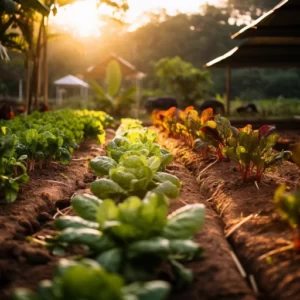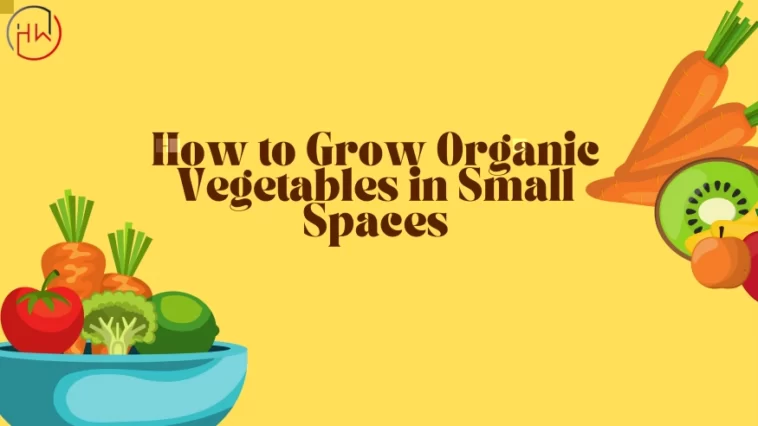You don’t need expansive gardening space to grow nutritious, homegrown organic veggies. Even the smallest outdoor nooks like urban yards, patios, balconies, and doorsteps can be converted into abundant edible oases. Follow this comprehensive walkthrough to successfully plant, maintain, and harvest bushels of fresh organic produce from a compact potager garden.
Selecting the Best Vegetables for Small Spaces

When planning your petite potager, choose compact, high-yielding vegetables that produce prolifically in confined square footage. While almost any vegetable can be grown in a container, some top performers for small spaces include:
Bush beans, which bear heavily on small plants perfect for pots and window boxes. Look for compact varieties like Provider or Contender. Beets, which mature quickly and are the ideal root crop for container culture. Mini varieties mature faster. Carrots also do well in deep containers. Opt for short rounded types like Paris Market versus long tapered roots.
Kale, spinach, lettuce, and other leafy greens thrive in cool weather and can be cut again and again for multiple harvests from one planting. Their shallow roots are ideal for smaller containers. Radishes are a perfect fast-growing urban crop that can be succession planted in tiny bare spots. Mini sweet bell peppers and hot peppers are prolific producers on pint-sized plants suited for patios.
Cherry tomatoes are ideal for the tomato lover with limited space. Their diminutive size means they take up less space while yielding buckets of sweet bursts of flavor. Prolific herbs like basil, parsley, cilantro, and chives complete any small space garden and thrive with frequent harvesting.
When planning your petite potager, focus on compact and container-friendly varieties that produce steadily throughout the season, even in confined square footage. This ensures your micro-garden yields the biggest bounty.
Setting Up the Growing Space
To successfully grow veggies in a small space, you’ll need to make the most of every inch available. Here are some key steps for establishing an optimal garden space:
- Ideally choose a spot that receives at least 4-6 hours of direct sunlight daily, the minimum most vegetables require.
- For in-ground planting, remove any grass or weeds and cultivate the soil, mixing in 1-3 inches of compost to enrich fertility and drainage.
- Building raised garden beds out of lumber, stones, or bricks instantly improves height and drainage too.
- Container gardens should be filled with a commercial organic potting mix amended with worm castings for nutrients.
- Ensure easy access to water, whether via an outdoor spigot and hose, or if on an urban patio, the ability to get water from the kitchen to your container plants.
Since space is limited, you need to make full use of vertical Gardening as well.
- Install wall mounted shelves or stacked crates to allow tiered planting arrangements.
- Erect trellises along walls, fences, or rails to allow vining crops to grow upward.
- Repurpose everyday items like buckets, boot trays, and storage baskets to create unique planters.
- A small space garden is all about using every inch available efficiently.
Starting Seeds and Planting Your Potager

Once your petite potager space is prepped, it’s time to get planting. There are two main methods for establishing plants: sowing seeds directly, or transplanting seedlings.
Many vegetables grow well from seed sown right in the garden soil or containers. Crops like lettuce, arugula, spinach, radishes, beets, carrots, bush beans, peas, and cucumbers can be directly sown into the ground where they will grow. Refer to the seed packet for specifics on planting depth, spacing, and ideal soil temperatures for that variety. When sowing in rows, use a hoe or trowel to make shallow furrows, space seeds appropriately down the row, then gently cover with soil and water.
Some vegetables fare better when started indoors from seed and later transplanted as young plants into the garden. These include tomatoes, peppers, eggplant, broccoli, cauliflower, and celery. Start by sowing seeds in sectioned seed trays or reusing egg cartons indoors 6-8 weeks before your last expected frost date. Keep seedlings consistently watered under grow lights or bright windows. Once they have at least 2 sets of true leaves, begin transitioning the young plants outside to harden them off to outdoor conditions. After about a week of hardening off, transplant seedlings into garden beds or containers by carefully uprooting, gently handling the stems to avoid damage, and placing each plant into holes or slots in their permanent growing positions. Water well and protect from harsh sun immediately after transplanting.
Whether sowing directly or transplanting starts, proper spacing for adequate air circulation and growth is key. Follow seed packet or plant tag guidelines for ideal spacing per variety. To maximize yield from every inch, practice succession planting by reseeding open spots throughout the season. This allows multiple harvests from each square foot of space.
Caring for Your Petite Potager Plants
Consistent and attentive care keeps container-grown veggies thriving. Here are some key organic gardening practices to follow:
- Check soil moisture daily, watering plants when the top inch of soil becomes dry. Container plants especially require vigilant watering to thrive in their confined spaces. But take care not to overwater either, as soggy soil promotes root diseases. Aim for consistent moisture without saturating the soil. Mulch garden beds and container soil with grass clippings, leaves, straw, or wood chips to conserve moisture and suppress weeds.
- Feed plants every 2-3 weeks with an organic liquid plant food or by “brewing” compost, manure, or worm castings into a nutrient rich compost “tea.” Just place the medium into old pantyhose or a porous bag, soak it overnight in a bucket, then use the resulting solution to feed plants.
- Install stakes, cages, and trellises for climbing plants like tomatoes, pole beans, peas, and cucumbers to contain their growth vertically. Prune off any suckers on tomato plants to devote energy to the main vines. Pinch back basil often to spur bushy growth.
- Be vigilant about checking for pests like aphids, cabbage worms, squash bugs or spotted cucumber beetles. Remove any insects by hand and dispose of them away from your garden to break their life cycle. As a last resort for large infestations, use an organic insecticidal soap derived from plant oils to control pests while protecting pollinators. Weeds compete with vegetables for nutrients, so pull unwanted greenery as soon as you spot it. Shallowly cultivate the top inch of soil which will uproot most young weeds. A well-tended garden means your plants get all the nutrients and space they need to thrive.
Harvesting Bounty from Your Tiny Veggie Patch
Here are some key pointers for collecting your homegrown harvest at its peak flavor and texture:
- Leafy greens like lettuces, spinach, arugula, kale and chard should be harvested while the leaves are young and tender for the best taste and texture. Use scissors or sharp pruning shears to snip just what you need, usually the outer leaves. The center will keep generating new growth.
- Pick peas, green beans, cherry tomatoes, peppers, summer squash, and cucumbers while they are on the younger, more tender side for ideal sweetness and crisp texture. Vining crops should be 6-8 inches long. Letting them grow too large leads to seeds and tougher flesh.
- Root veggies like carrots, radishes, and beets should be harvested once they reach an appropriate size for that variety but before they exceed their prime. Younger roots tend to be more tender. Time carrots and parsnips based on the “days to maturity” noted on the seed packet.
- Unlike other crops, tomatoes must be left on the vine until fully red ripe to allow their sugars to develop for ideal flavor. Carefully twist off the fruits with their stems still attached.
- Use clean, sanitized gardening shears and knives to harvest greens and herbs like basil, parsley, sage, and thyme for the cleanest cuts that won’t damage the remaining plant.
Preserving and Using Your Petite Potager Bounty
Part of the fun of growing your own edibles is enjoying the fruits of your labor in creative ways:
- Gently wash produce immediately after picking. Discard any spoiled portions and store greens, green beans, peppers and tomatoes in the refrigerator where they’ll keep for up to a week.
- Highlight fresh flavors by using produce immediately after harvest. Baby carrots and radishes make for crisp snacks. Salad greens and herbs add instant flavor. Sauté greens, squash, and snap peas to accompany meals.
- Preserve abundant harvests through freezing, canning, dehydrating or fermenting to enjoy long term. Store winter squash, onions, garlic, potatoes and root veggies like beets, carrots and parsnips in a cool, dry basement or garage through fall and winter.
- Infuse vinegars, oils and honey with herbs like basil, thyme and rosemary. Make pesto and tomato sauce. The possibilities are delicious and endless!
- No matter how compact your gardening space, you can experience the immense satisfaction of sustainably feeding yourself from a thriving potager.



GIPHY App Key not set. Please check settings